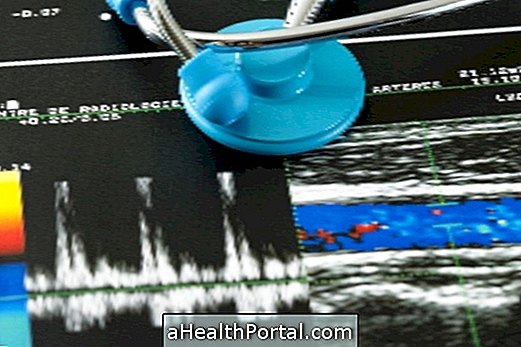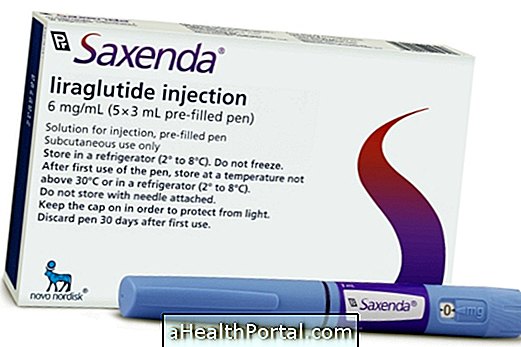Doppler ultrasound, also called Doppler ultrasound or color Doppler ultrasound, is an important test to evaluate blood vessel circulation and blood flow in a particular organ or region of the body. Thus, it may be requested by the physician in cases of suspected narrowing, dilatation or occlusion of a blood vessel.
For example, some of the major indications for this test are thrombosis, aneurysms, or varicose veins, for example, and it is also widely used during pregnancy to see if fetal blood flow to the fetus occurs properly, known as fetal Doppler.
Like the common ultrasound examination, Doppler ultrasound is performed through an apparatus capable of emitting sound waves, which reach the tissue and return as an echo, which is converted into images. The Doppler is the additional one that is able to identify and visualize the blood flow at the site. Learn more about the main types of ultrasound and when they are indicated.

Doppler ultrasonography is done by the physician in imaging clinics or in the hospital, being available free of charge by the SUS or included in health plans. In particular, this exam can cost around 200 to 500 reais, however, the price is very variable according to the place where it is done, the area observed or if there are additional to the examination, such as 4D technology.
What is it for
Some of the main situations in which it is indicated to do an ultrasound with colored doppler are:
- Study the functioning of the blood flow of arteries and veins;
- Detect venous or arterial thrombosis;
- Diagnose and evaluate varices;
- Measure the blood flow from the mother to the fetus, through the placenta, during pregnancy;
- Identify aneurysms or dilatations in blood vessels;
- Identify narrowing or occlusions in the veins and arteries.
The sound waves generated during the examination produce the image directly to the computer screen of the device, so that the doctor can see if there are changes.
Care for the exam
The Doppler ultrasound examination is simple and painless, requiring only lying on the stretcher while the doctor carries out the examination. It is not usually necessary to fast, except in the exams performed in the abdominal region, such as aortic Doppler or renal arteries.
In these cases, a fasting of 10 hours and the use of gas medicine, such as dimethicone, may be indicated to decrease the formation of gases that may interfere with the test.
Main types
Color Doppler ultrasound can be requested to assess virtually all regions of the body. However, some of the doctor's main requests are for:

1. Doppler ultrasound of the legs
Called doppler of the lower limbs, it is often asked to identify varices, thrombosis, narrowing of blood vessels, to evaluate blood circulation before surgery in the region or even to evaluate the presence of symptoms of venous or arterial insufficiency, also called poor circulation .
Understand what can cause poor circulation and the main symptoms.
2. Doppler obstetric ultrasound
Also known as fetal Doppler, it is indicated by the obstetrician, and it is used to evaluate the blood vessels and the velocity of the blood flow of the umbilical cord and the placenta, noting if there is any alteration in the blood flow to the fetus, in order to program better forms or the time for delivery.
This test is usually done in the third trimester of gestation, between 32 and 36 weeks, and is especially necessary if the doctor suspects any changes caused by situations such as below-expected growth, maternal diabetes, altered amniotic fluid, gestation of twins or decreased movement of the fetus, for example.
3. Thyroid Doppler Ultrasound
The thyroid Doppler can be indicated by the endocrinologist to evaluate the characteristics of the blood vessels of the thyroid, in order to help program punctures. It is also useful for identifying malignancy characteristics of a nodule, since the presence of excess blood vessels may be another indication of suspected nodule.
Learn more about when the thyroid nodule may be cancer.
4. Carotid Doppler Ultrasound
The carotids are arteries that carry blood from the heart to the brain, and when they undergo any changes, such as obstruction or narrowing, they can cause symptoms such as dizziness, fainting or even causing a stroke.
Therefore, carotid Doppler is indicated by the physician when these changes are suspected, to assess the risk of stroke and also in people who have suffered a stroke, to help identify the cause. Learn more about what carotid ultrasound is for.
5. Doppler Ultrasound of Renal Arteries
It is usually indicated by the nephrologist to study the flow of the kidneys' arteries, seeking to identify narrowings and occlusions of these vessels, which are causes of arterial hypertension of difficult control.
They may also be indicated to look for causes of kidney changes, such as decreased size, suspected aneurysms, or deformities.
6. Doppler ultrasound of the aorta
It is indicated to evaluate the presence of dilatations or an aneurysm in the aorta, which may be suspicious in people who have an abdominal murmur. It is also useful to investigate a dissection in this vessel, which is a serious complication caused by detachment of its walls, or even to observe the presence of plaques of atherosclerosis that can cause obstruction of the aorta.
This examination is also very important for scheduling corrective surgery, if indicated by your doctor. Check how to identify the aortic aneurysm and how to treat it.
























